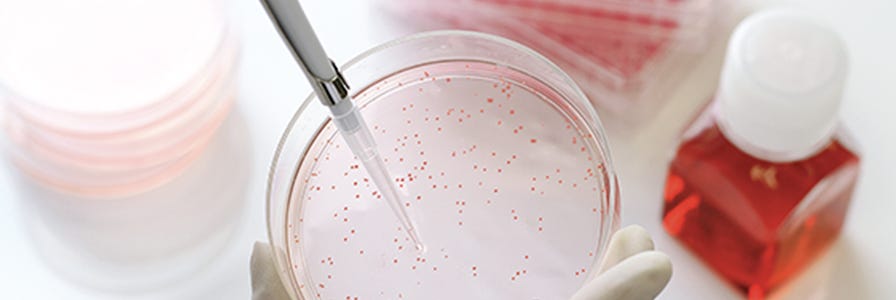Integrating Electrofusion with the ClonaCell™-HY Workflow for Hybridoma Production
Hybridomas are generated by fusing antibody-secreting B cells with appropriate myeloma fusion cell lines. Traditionally, the fusion was achieved by treating the cell suspension with polyethylene glycol (PEG). In recent years electrofusion has gained popularity as a fusion technique for generating hybridomas. Electrofusion allows for more control over the fusion conditions, higher efficiency, as well as better growth properties following fusion. Additionally, it can be performed with a smaller number of cells. For these reasons, electrofusion is often favored when working with purified B cells or plasma cells. The ClonaCell™-HY product line includes reagents for PEG-based fusion, but is also fully compatible for generating hybridomas with electrofusion.
There are a variety of electrofusion instruments available. Below are suggested protocols for performing hybridoma electrofusion using an Eppendorf® Multiporator®—a small-scale instrument—or the Harvard BTX ECM2001, a large-scale instrument. Electrofusion conditions may need to be further optimized to achieve the highest fusion efficiency with each instrument, cell type, and fusion chamber.
Materials
- ClonaCell™-HY Medium B (Catalog #03802)
- Eppendorf® Multiporator® or Harvard BTX ECM2001
- ClonaCell™-HY Medium C (Catalog #03803)
- T-flask (Catalog #38072)
- Centrifuge
Protocol
I. Preparation of Myeloma Cells and Splenocytes
- Harvest mouse splenocytes from spleen and myeloma cells from culture and wash 3 times with ClonaCell™-HY Medium B, as directed in ClonaCell™-HY Hybridoma Kit manual. Resuspend cells in ClonaCell™-HY Medium B at appropriate concentrations, i.e. 1 - 2 x 106 cells/mL.
- Optionally, splenocytes can be enriched for B cells or plasma cells prior to fusion using EasySep™ cell separation kits (Table 1). Using isolated cells for fusions has been shown to increase fusion efficiency and antigen-specific positive hit rates (poster).
Table 1. Recommended EasySep™ Cell Separation Kits for B Cell Isolation
II. Electrofusion
- Combine myeloma and splenocytes/B cells/plasma cells for fusion, as follows:
- For unenriched total splenocytes, the recommended ratio of splenocytes to myeloma cells is 5:1
- For enriched B cells or plasma cells, the recommended ratio of enriched cells to myeloma cells is 1:1
- Number of cells required per electrofusion:
- Eppendorf® Multiporator®: 0.5 - 1.5 million cells using Helix Fusion chamber
- Harvard BTX ECM2001: Up to 20 million cells, depending on chamber size used
- Wash the combined cells 2 times using the electrofusion buffer supplied by the vendor of the electrofusion instrument.
- Resuspend washed cells in an appropriate volume of electrofusion buffer for fusion chamber size. Transfer combined, washed cells to electrofusion chamber.
- Connect the fusion chamber to the electrofusion instrument and apply the recommended settings in Table 2. Alignment and pulse voltages and times may be further optimized based on performance, as required.
Table 2. Recommended Settings for Electrofusion
Electrofusion InstrumentAlignment VoltageAlignment TimeFusion Pulse VoltageFusion Pulse TimeNumber of Pulses (n)Eppendorf ® Multiporator®6 V30 s25 V15 μs3Harvard BTX ECM200135 V20 s3000 V10 μs1 - After the fusion program is completed, allow the chamber to stand for 10 minutes.
- Remove the fusion chamber and rinse the electrode core and/or fusion chamber with ClonaCell™-HY Medium C to recover the fusion product.
- Transfer fused cells from the fusion chamber to an appropriate sized T-flask containing ClonaCell™-HY Medium C. Incubate for 16 - 24 hours at 37oC in 5% CO2 to allow fused cells to recover prior to HAT selection.
III. HAT Selection and Screening
- After overnight recovery, centrifuge electrofusion product and resuspend in ClonaCell™-HY Medium C.
- Transfer the resuspended fusion product into ClonaCell™-HY Medium D and plate on a 100 mm dish for HAT selection, as directed in ClonaCell™-HY Hybridoma Kit manual.
a. For total splenocyte fusions, plate 3 - 5 x 106 cells per plate
b. For B cell or plasma cell fusions, plate 0.5 - 1.5 x 106 cells per plate. - Incubate ClonaCell™-HY Medium D plates at 37oC in 5% CO2 for 10 - 14 days for selection of hybridomas.
- Pick the surviving hybridoma colonies from Medium D plates into 96-well plates containing ClonaCell™-HY Medium E.
- Expand the picked hybridomas in Medium E for 3 - 4 days and then screen for antigen-specific antibodies using ELISA, flow cytometry, western blot, or other methods.
Request Pricing
Thank you for your interest in this product. Please provide us with your contact information and your local representative will contact you with a customized quote. Where appropriate, they can also assist you with a(n):
Estimated delivery time for your area
Product sample or exclusive offer
In-lab demonstration




